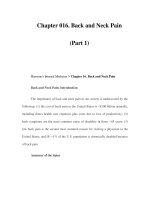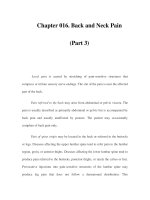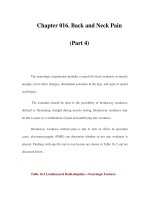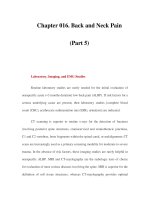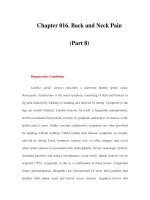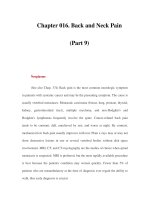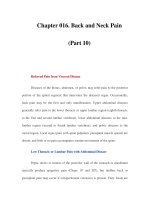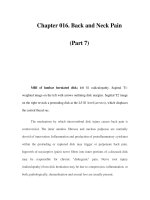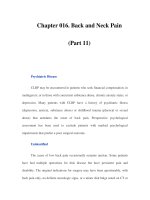Chapter 016. Back and Neck Pain (Part 1) ppsx
Bạn đang xem bản rút gọn của tài liệu. Xem và tải ngay bản đầy đủ của tài liệu tại đây (1.04 MB, 6 trang )
Chapter 016. Back and Neck Pain
(Part 1)
Harrison's Internal Medicine > Chapter 16. Back and Neck Pain
Back and Neck Pain: Introduction
The importance of back and neck pain in our society is underscored by the
following: (1) the cost of back pain in the United States is ~$100 billion annually,
including direct health care expenses plus costs due to loss of productivity; (2)
back symptoms are the most common cause of disability in those <45 years; (3)
low back pain is the second most common reason for visiting a physician in the
United States; and (4) ~1% of the U.S. population is chronically disabled because
of back pain.
Anatomy of the Spine
The anterior portion of the spine consists of cylindrical vertebral bodies
separated by intervertebral disks and held together by the anterior and posterior
longitudinal ligaments.
The intervertebral disks are composed of a central gelatinous nucleus
pulposus surrounded by a tough cartilaginous ring, the annulus fibrosis; disks are
responsible for 25% of spinal column length (Figs. 16-1 and 16-2).
The disks are largest in the cervical and lumbar regions where movements
of the spine are greatest. The disks are elastic in youth and allow the bony
vertebrae to move easily upon each other. Elasticity is lost with age. The function
of the anterior spine is to absorb the shock of body movements such as walking
and running.
Figure 16-1
Vertebral anatomy. (From A Gauthier Cornuelle, DH Gronefeld:
Radiographic Anatomy Positioning. New York, McGraw-Hill, 1998; with
permission.)
Figure 16-2
Spinal column. (From: A Gauthier Cornuelle, DH Gronefeld:
Radiographic Anatomy Positioning. New York, McGraw-Hill, 1998; with
permission.)

